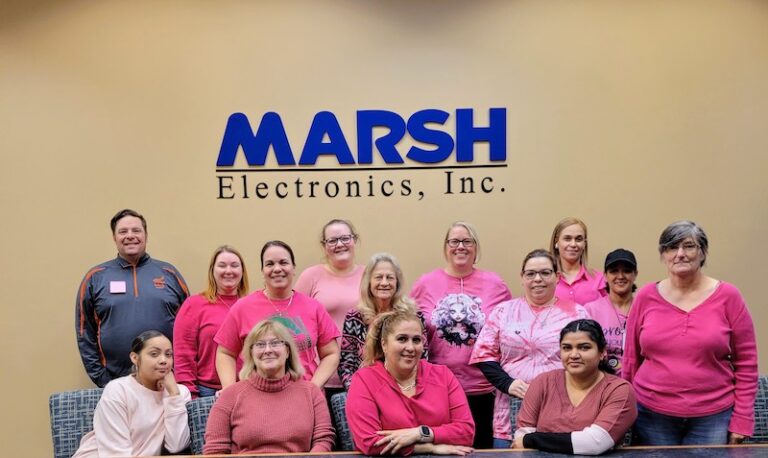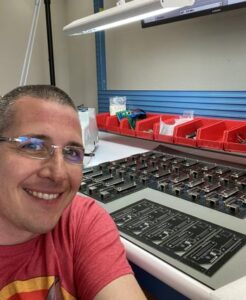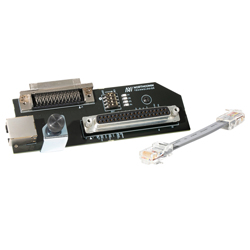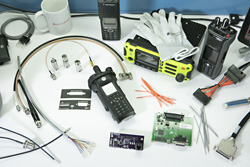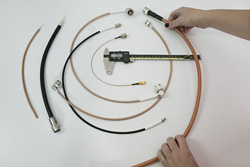Company Profile: Northcomm Technologies
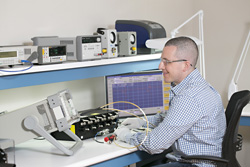
We’ve covered many inspirational boot strap stories in previous Profiles. The story of Mark Danon, the owner of Northcomm Technologies, is very inspiring, but also somewhat unique. Many embarking on their entrepreneurial venture have come from positions of engineering or technical sales who started their business in their garage or basement. Mark Danon was an NYPD police officer who started his business in a tiny New York City apartment. But the beginning of this story goes back much further than that — back to Marks college days in New York.
During summer breaks throughout college and graduate school, Mark worked for a couple of two-way radio dealerships. Both carried equipment manufactured by a major player in the public safety communications arena. “Doing that job through those many summers, I saw a lot of interesting opportunities where these dealerships were making one-off products to satisfy customer requirements,” he recalled. “These were products where it seemed as though someone should be mass producing them. And more often than not, they were cable assemblies.”
Upon completion of his master’s degree, Mark went to work for the NYPD in a number of different capacities. He started as a uniformed officer, then a sergeant, and eventually obtained a position at headquarters. During this last assignment, he worked on large citywide projects standardizing process and procedures across precincts. “My work at the police department was really about my interest in public service, and I really enjoyed that job.”
Throughout his time at NYPD, Mark continued to reflect on his days at the radio dealerships as he began to see problems with communication equipment. His intimate knowledge and interest surrounding two-way radio systems led him to create a solution in the form of a single product. That product was a multi-conductor cable assembly that would allow operators of a very popular transmitter to connect that transmitter to third-party audio routing devices. “The reason I targeted this specific transmitter is because it was the most popular public safety transmitter out there, and integrating it through its audio routing system is a key thing that end users would want to do,” he explained.
Mark came up with a design, standardized the cable, and began building it in his apartment using mostly manual processes. He started selling through word-of-mouth, leveraging his dealer relationships and the many contacts he made during his years in the communications industry.
Through further iterations of the product to accommodate different configurations, the focused product line was showing signs of becoming an economically viable and a full-time venture. As a bonus, Mark really liked the work, so he took the leap.

Over time, Mark established some strong relationships with a major public safety communication OEM. He was approached and asked if he could make a very specialized microphone device, for one of the largest 911 call centers in the United States. “This microphone system would allow 911 dispatchers to speak directly with the police, fire and EMS people,” he described. “I knew exactly what they wanted as far as form, fit, function and durability, because I knew the culture.”
Within a month, he handed a prototype to the OEM who showed it to the customer. It was no surprise to Mark that they loved it, and soon orders were pouring in. “Every single 911 call that goes through this major public safety radio system, goes through a microphone and preamplifier made by Northcomm Technologies.”
The ball was rolling, and Mark was contacted by different project managers and field people at the OEM to see if he could produce more products to solve other problems. “At this time, we were focusing mostly on multi conductor wire harness products, and I thought that we needed to find a way to decrease the human touch, and increase our ability to have higher throughput with fewer errors,” he explained. “I know everybody says this, but for me it really is about impeccable quality, and 100% perfection is what I’m after every time. The people that are using this stuff are doing a job that I used to do, and I take that very personally.”
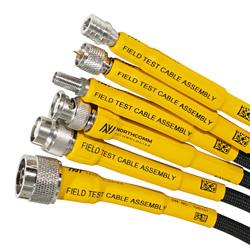
In pursuit of this goal, Mark began researching automation products that would increase his throughput while satisfying his obsession with quality. One supplier in particular emerged favorably in Mark’s eyes. “I know this is going to sound like a sales pitch for Schleuniger, but it’s really not. I found out about them and this entire world of professional cable harness manufacturing equipment.” The Schleuniger salesperson paid him a visit, and Northcomm started with one machine, a UniStrip 2300. “Eight or ten Machines later, and I can produce one of these assemblies in about 1/10 of the time that I used to with microscopically inspectable perfection, and the product just continues to improve.”
Also around this time, it became painfully obvious to Mark that his New York City dwelling was not going to sustain the growth of his fledgling business. “From a facility standpoint we needed to leave New York City, but it was mostly for personal reasons. I mean, I thought it was cool to leave New York before Covid — the economics just made sense.”
With family in Texas, Mark had become familiar with the Dallas-Fort Worth area. There were plenty of houses available that would give him the extra space he needed to grow the business. “I didn’t want to invest in buying a building just then. I wanted to invest in machinery because it was the machinery that was allowing us to be hyper competitive.” Mark found a home in the DFW area that had an extra outbuilding space to accommodate their needs. They fitted those areas with workstations for the various processes and testing procedures.
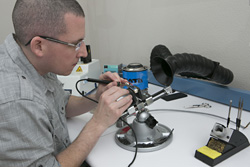
Mark has always sought to move Northcomm in new directions, seeking the next best move in technology to develop the product line. He saw the need to push the company in the direction of RF. “I knew we needed to be doing something with 50-ohm coaxial cable, and we couldn’t do that until we bought the machine to touch that kind of wire,” he explained.
Somewhat serendipitously, Mark was then approached by another project manager at the OEM to solve a problem they were having building the transmitters for a large metropolitan rail system. The transmitters were going into very specialized cabinets, and the OEM couldn’t use their normal coaxial cable because it wouldn’t fit. “They needed somebody to manufacture the coaxial cable sets to connect those transmitters to what are called combiners. And those combiners connect those transmitters to the antennas which represent the spinal cord of the entire system,” Mark detailed. “If those cables aren’t perfect, you will have any number of very hard to diagnose problems with the system. It’s not just a ‘works or doesn’t work’ situation. You could have intermittent problems, noise, interference or a whole number of things.”
Of course, he told them he could absolutely do it. He created a design spec that the customer reviewed and liked. For Mark, this was the opportunity that would allow him to buy the expensive coaxial equipment. “We went to Schleuniger and they gave us a fabulous deal on our first coax machine. We promised the customer we were going to deliver in four to eight weeks, and we got it done in two.” Northcomm already had invested in a Rohde & Schwarz vector network analyzer to measure RF components, so they were able to serialize and provide individual data on every single cable. That level of data has become the hallmark of the company’s coaxial cable products.
After that great success, Mark began to look at his business as not just wire harnesses, but as an entire product portfolio in support of public safety two-way radio communications. “I said that I would like to think about eliminating multi-conductor cable harness assemblies in certain spaces, and substitute those for circuit boards.” Mark saw an opportunity with an interface plug used in the backbone transmitter of practically every major public safety radio system in the United States. “That interface plug presented an enormous number of connection challenges, and the OEM’s solution was a very large and complex cable harness assembly. The customer needed a lot of rack space if they wanted to plug into this connector, and rack space is like New York City apartment space — there’s a big premium there.” So, Mark developed a small circuit board that eliminated all of the cabling and allowed the OEM’s customers to rapidly plug into the base station without complicated wiring and without losing precious rack space. “It’s just a little circuit board, and it’s one of those ‘I should’ve thought of that’ products, and we’ve been selling a whole bunch of those to The US government. And so, circuit boards have now become an actual vertical for us because we developed the expertise and the vendor network to help us get that done.” Mark thought of the idea one day while standing at the car wash waiting for his car. Three months later, he had a product, with a patent pending, ready for sale, and in the customers hands.
Alongside the circuit board product, the OEM recently selected Northcomm in a competitive bid to manufacture all the coaxial cables for all of the cabinets within one of the largest police radio systems in the United States. “As far as I know, this particular system is one of the largest police radio systems in the United States by a mile. That project is going to keep us busy for years,” Mark outlined.
For that project they actually beat out other vendors, not just because they offered the highest quality, but because they were able to offer traceable data with every single cable sold. “We offered them the performance data and serialization for each cable, and that gave them the confidence to know that they were not going to have any problems with our products because they are tested in a very rigorous and verifiable way.”
With all these major successes and because he now have employees, Mark is in the process of looking for a larger location to house the operation. “I don’t believe in renting or leasing anything, so we want to build a small building and actually take that next step. It’s an expensive proposition, but it’s necessary to sustain our growth.”
In conclusion, Mark had this to say about his experience thus far:
I’d like to tell you that from a personal standpoint this experience of running a small business and being able to have the honor of servicing these incredibly meaningful customers has been the most exciting experience of my life. It was very difficult leaving the NYPD because I absolutely loved my job. I got to work with incredible people doing incredible work that I just loved. A lot of people don’t understand that law enforcement is about improving the lives of others. And now I get to make these products that help people improve the lives of others. It’s just incredibly fun. So, for me, it’s not just manufacturing cable assemblies or wire harnesses. It’s an entire product portfolio, and I’m always thinking about what we are going to do next.
The future looks bright for this innovative manufacturer. If you’d like to see some of the incredible products Northcomm is marketing, jump on their website at northcommtechnologies.com. And keep an eye on them as they blaze a trail in the two-way communications arena.














































